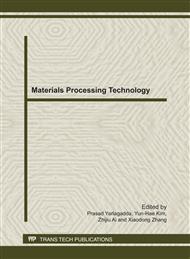p.163
p.171
p.178
p.184
p.188
p.192
p.198
p.203
p.209
Numerical Simulation on Temperature History during Cooling Process of Wire Rod
Abstract:
A one-dimensional mathematical model of wire rod during cooling was developed. This model considered the heat of phase transformation during the cooling process. Based on the energy-balance method the equations were calculated, and the temperature history during cooling process of wire rod was obtained. The comparison of the calculated results with the measured results showed that the model worked well for simulating the temperature history of wire rod during cooling process. The effects of roller speed, diameter of wire and fan delivery on temperature history of wire were analyzed. With this developed model, the optimizing of cooling processes of wire rod can be investigated in the future.
Info:
Periodical:
Pages:
188-191
Citation:
Online since:
September 2011
Authors:
Keywords:
Price:
Сopyright:
© 2011 Trans Tech Publications Ltd. All Rights Reserved
Share:
Citation:


